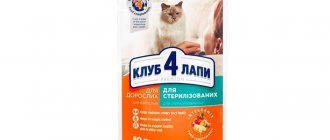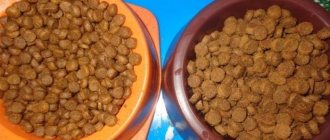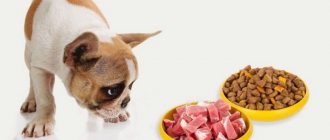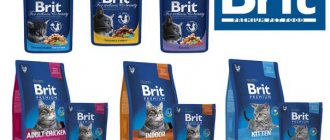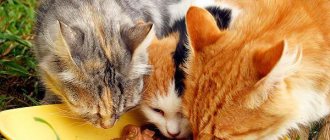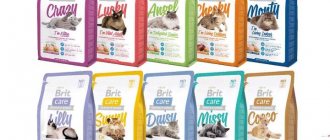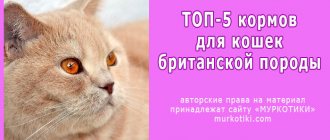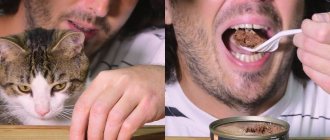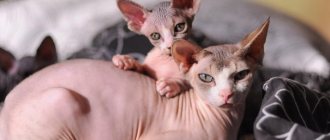Wet food for kittens is a compromise between a natural menu and dry ready-made diets. Most often, canned food and spiders are used as an intermediate when converting to granules, since they cannot be the basis of nutrition. Wet food is more similar in texture to natural food, so it is less likely to cause gastrointestinal problems.
- 2 Types of wet food for kittens
- 3 Classes of wet food for kittens
- 4 What is the difference between wet food for kittens and diets for adult cats?
- 5 Table: overview of popular wet food for kittens
- 6 Reviews from veterinarians about wet food for kittens
- 7 Reviews from pet owners about wet food for kittens
Advantages and disadvantages of wet food for kittens
The key benefit of wet kitten food is that it saves time. Product recipes are prepared by professionals, taking into account all age characteristics and biological needs of animals. The owner just has to open the bag and fill the bowl. When eating natural products, owners have to calculate individual daily norms of nutrients. Ideally, you should take into account the breed, weight, age of the kitten and other characteristics. This forces the owners to update the menu from time to time as the kids grow. The worries don’t end there: you need to buy food and cook food from it. At best, it will be a mixture of meat with offal, which you can stock up on for future use and boil as needed. At worst, you will have to stand at the stove every day. You should also consider the time it will take to find reliable sellers and visit the market and shops.
If the owner is not confident that he is able to create a balanced menu on his own, it is better to use ready-made rations
Using wet food reduces the risk of infection. Natural products may contain viruses, worms and protozoa. You can partially protect yourself if you purchase certified products, but in practice it is either not possible to find sufficiently high-quality meat, or the seller does not have the necessary documents. And the threat of infection remains in any case, albeit minimal. Only those who have their own farm can afford to feed their pet high-quality natural products. In the process of preparing wet food, the ingredients are subject to strict control and heat treatment. Preservatives are used to prevent the development of bacterial colonies. However, it must be taken into account that wet food quickly deteriorates when exposed to air: even when stored in the refrigerator, you will have to get rid of the remains after 24–36 hours. Dry granules are safer in terms of safety.
When feeding natural products and wet food, it is strongly recommended to abandon plastic bowls or change them at least every month: the surface is easily scratched and food particles get into the damaged areas
Wet food is close in consistency to natural products, which makes it an intermediate link between the natural menu and dry diets. Pates and pouches are an ideal option for breeders. With such nutrition, future owners will be able to painlessly transfer kittens to both a natural menu and dry food. Pates can also be used as complementary foods for babies up to 4-6 weeks. The soft consistency prevents harsh effects on the gastrointestinal tract and subsequent inflammation, which often occurs when suddenly switching to granules.
Small kittens should only be given soaked dry food until their bite is formed.
The disadvantages of wet food include their high cost. Even economy class products have a significant impact on the budget. For example, 1 Whiskas pouch costs 20–25 rubles. The manufacturer recommends giving 3-4 sachets per day to older kittens over 3 months old. In fact, this quantity is not always enough: my neighbor feeds his kitten with economy class spiders, following the manufacturer’s recommendations. The pet is very thin and constantly hungry. This can easily be explained by the low nutritional value of economy-class feed. Even if the animal has enough food, the owner will have to spend 60–100 rubles per day. In a month it will cost 1800–3000 rubles for a pet. For the same money you can buy a large (3-5 kg) package of dry holistic, which will last for 6-10 weeks.
It is strongly recommended not to purchase wet food with thick sauces: their production uses thickeners that can irritate the pet’s gastrointestinal tract
Another problem with wet food is its poor composition. If you can add not only meat and offal to the granules, but also a complex of herbs, vegetables and fruits, then in the case of pates the manufacturer is limited by the production technology. This creates a paradox: it is almost impossible to purchase a complete holistic diet, since elite diets should not contain vitamins and minerals in their pure form, and it will not be possible to include many sources of nutrients in the composition. At the same time, almost all economy-class wet food is complete. Manufacturers add vitamin and mineral complexes to them, which are poorly absorbed. As a result, theoretically there seem to be enough nutrients in the diet, but in fact most of them leave the body without being absorbed into the gastrointestinal tract. Because of this, kittens develop a deficiency and develop diseases of internal organs.
Without help, fistula formation, tissue infection and further blood poisoning may occur.
The consistency of wet food is both a plus and a minus. With prolonged feeding of such foods, the baby’s gastrointestinal tract adapts to digest only softened food. In the future, this creates problems when switching to another type of diet. In most cases, digestive disorders occur. Wet food does not contain enough coarse fiber, which causes poor peristalsis. The kitten may have constipation or diarrhea. A friend of mine’s cat’s anal glands became inflamed when she was 9 months old. Normally, they are cleaned with dense feces, but with prolonged diarrhea due to poor nutrition, the secretion accumulates and clogs the pouches. The cat had to clean his glands by hand. Despite nutritional correction, they still periodically become inflamed in the pet. For this reason, even complete wet foods should be combined with dry kibble or natural products.
Types of packaging forms
The next criterion by which canned cat food differs from each other is the form of packaging.
There are 6 main options:
- Tin can (regular or with a special “easy open” ring for quick opening).
- Glass jar with a tight-fitting tin lid.
- Pouches (the word “pouch” is translated from English as bag, pocket, pouch) are special sealed bags made of soft polymer material, laminated on the inside with food foil.
- Lamisters are soft, small (per serving) containers made of aluminum foil, laminated on the outside with polypropylene film and sealed on top with the same laminated foil.
- Tetra-packs are boxes made of special six-layer material (polyethylene, cardboard, polyethylene again, aluminum foil and 2 more layers of polyethylene), which allows for maximum preservation of all the beneficial properties of the food without additional cooling.
- Plastic pots sealed with a foil lid.
There is another special form of wet cat food - loaves. This is a shell made of plastic film, fixed on both sides with metal clips, inside which there is food.
However, this packaging method is not canning; it is a regular package of cat sausage (usually frozen), it should be stored in the freezer, and used immediately after defrosting.
In addition, wet food can be packaged in disposable transparent plastic containers (soft cheeses, fish pastes, salads and other dishes are often sold in these containers). The packaging is also not canned, so it would be incorrect to include it in the list above.
The above fully applies to vacuum packaging, which is sometimes used to sell cat sausages or sausages.
Important! The main properties of canned food packaging are absolute tightness, complete absence of contact with the environment and chemically neutral material with which the contents (container and lid) come into contact.
Modern forms of packaging wet food (plastic pots, pouches and tetra-packs) are extremely convenient to use. The animal eats the contents of one portion immediately, and in the first two cases the owner does not even need to pour the contents of the package into a bowl, because the food is in a ready-made disposable container.
Other advantages of this form of packaging include:
- compactness;
- environmental friendliness and safety;
- ease of disposal of used containers;
- the opportunity to diversify your pet’s diet;
- longer shelf life (what is not intended for immediate consumption remains hermetically sealed).
But there is also a significant drawback: if the cat does not cope with the treat right away, saving it until the next meal is quite problematic, because you cannot put the foil lid on the tray, and it is impossible to close the torn envelope at all.
Some manufacturers produce lamisters and tin jars with special plastic lids, but this additionally increases the cost of the product.
In such cases, it is more correct to transfer the remaining food into glass containers, but we are talking about such small quantities that this causes more inconvenience than savings.
Important! Purchasing canned cat food in high-tech packaging, dosed for one meal, is much more expensive: traditional forms of packaging, designed for several days, are significantly cheaper.
When giving preference to one option or another, you should focus on your pet’s appetite, because if a cat happily eats the contents of a half-liter glass jar for two days, by using such containers the owner can significantly save on food without compromising the health of his pet.
Classes of wet food for kittens
There is no single official division. Conventionally, there are 4 classes of food: economy, premium, superpremium and holistic. Let's look at each category separately.
Economy class food is the worst among ready-made diets. Cheap raw materials are used in their production. Most often this is waste: feathers, bones, beaks, etc. The proportion of meat is minimal, most of the composition is occupied by water and grains. These foods can only be called nutritious: they contain proteins, fats, carbohydrates, vitamins and minerals, but they are practically not digestible. Kittens should not be given such diets, as they can provoke the development of pathologies.
Economy-class food does not allow the kitten’s gastrointestinal tract to develop normally, which is why it cannot subsequently eat high-quality diets or has difficulty transitioning to them.
Premium food is not much different from budget products. The meat content in them reaches 20% instead of 10%, but this is still not enough. In general, the quality of raw materials leaves much to be desired, but there are some acceptable items. These can be whole chicken carcasses, fish oil or good offal - liver, lung, hearts, etc. However, premium food is also not suitable for regular nutrition.
A distinctive feature of premium food is aggressive advertising, due to which many pet owners mistakenly consider diets in this category to be the best.
Super premium diets are a more acceptable option. Among them there are grain-free pates and pouches. If the composition contains vegetables and fruits, then their variety is indicated. The share of herbal supplements is lower. Manufacturers use high-quality raw materials and specify their type. Super premium feeds do not contain such common names as “bird”, “fish”, etc.
The cost of super premium food often does not exceed the price of premium diets, but in terms of quality the difference is colossal
Holistics are elite diets that contain only the best products. If this is a fish, then it must be raised in the wild. If it's a bird, then it's free-range. No hormones are used in raising animals. Herbal ingredients are minimally processed. The information indicated on the packaging is always true, as confirmed by Roskachestvo research.
Holistic products are almost impossible to purchase in pet stores; they have to be ordered online, but it’s worth it
What is the difference between wet food for kittens and diets for adult cats?
Wet food for kittens contains more fat and protein, as well as increased concentrations of phosphorus, calcium and magnesium. The difference is due to the characteristics of the body: babies require nutrients for the rapid development of internal organs.
Kitten foods can be dangerous for adult cats. The latter, with poor nutrition, are at risk of developing obesity, diabetes and urolithiasis. Absolutely healthy kittens can eat high-quality wet food for adult cats without negative consequences, but with the slightest deviation from the norm there is a chance of worsening the condition, so experimenting is not recommended. There are universal wet foods that are suitable for both babies and mature animals.
Table: overview of popular wet foods for kittens
| Name of food | Class | Texture and packaging | Kitten age | Compound | Average cost and weight of packaging | Advantages | Flaws | Overall rating |
| Almo Nature Classic Cuisine Kitten | Holistic | Spiders, however, also have food in cans. The pieces are relatively large, but not very dense. The best option for older kittens | 2–12 months |
| 90 rub. for 55 g |
|
| The composition is relatively weak and does not correspond to the inflated price. Rice is supposedly used as a source of fiber, but a healthier ingredient could have been chosen. Bones and shell fragments have been found in food for adult cats, so be careful when purchasing these canned foods! |
| Royal Canin Mother&Babycat | Premium | Mousse in cans | 1–4 months |
| 100 rub. for 200 g |
|
| Despite aggressive advertising, the quality of Royal Canin food is low. Since the manufacturer does not indicate the type of cereal, it can be assumed that the composition includes the most dangerous ones - corn and wheat. They often cause allergies. Most likely, low-quality raw materials are used, since the list of components contains many vague names. The cost of food is very high. |
| Hill's Science Plan Kitten 1st Nutrition Mousse | Premium | Mousse in cans | From 3 weeks to 12 months |
| 70 rub. for 85 g |
|
| Hill's wet food has a mediocre composition, but compared to many popular products, its cost is not so high. However, this is still a premium class, so the presence of the product on the kitten menu is undesirable. |
| Applaws Kitten Tuna | Holistic | Small pieces in a tin can | Not specified by the manufacturer |
| 90 rub. for 70 g |
|
| Wet food cannot be used as the main diet. It is given only as a treat. There is only 0.5% fat in the food, many vitamins are missing, so if you regularly eat canned food, there is a high probability of deterioration in health. Using fish as the main source of protein makes it possible to offer a treat to allergy sufferers. Russian labels indicate that the composition contains a gelling component, although this is not the case in the English version. This is most likely a translation error, since the consistency of the broth is very thin. |
| Leonardo Finest Selection Kitten Poultry | Superpremium | Minced meat in jelly, packed in pouches | From 3 weeks |
| 110 rub. for 85 g |
|
| Although the thickener in the food is natural, it would be better without it, since it does not provide any nutritional value for kittens. |
Poll: best canned cat food?
Which canned food will you choose?
GO!
16.07 % ( 9 )
Almo Nature
5.36 % ( 3 )
Applaws
7.14 % ( 4 )
Bozita super premium
14.29 % ( 8 )
Berkley
17.86 % ( 10 )
Monge Cat Natural
1.79 % ( 1 )
Ontario
10.71 % ( 6 )
Pro Plan
14.29 % ( 8 )
Brit Premium
5.36 % ( 3 )
Organix
5.36 % ( 3 )
Reviews from veterinarians about wet food for kittens
Royal Canin food is made from quality ingredients, but not all ingredients are suitable for feeding cats. The main disadvantage is the presence of plant proteins, which are digested 30% worse than animals. Cereals are responsible for the carbohydrate component, and soybean oil is responsible for the fats. The food turns out to be balanced, but not very healthy, not the most nutritious. The manufacturer solved this problem by adding vitamins, minerals and other beneficial substances. The result is food on which animals feel great and lead an active lifestyle at any age. It is interesting that according to Russian standards the food falls into the premium category, but according to European standards it falls short. It is better to buy food produced abroad. Despite the fact that in Russia they are manufactured under license using good equipment, they are inferior to the original. I would like to draw your attention to the availability of an analogue of cat milk for feeding kittens. In the future, they do not lag behind ordinary kittens in development.
Pavlovskaya Ekaterina Viktorovna
https://otzyvkorm.ru/royal-canin-dlya-koshek/
Hills is the true premium segment. I can’t call it very nutritious, the energy value is average. The specified daily allowance may not be enough; pets feel hungry. However, the food is completely balanced and complete. You can make it the basis of your diet without fear for your health. A significant disadvantage is the overuse of difficult-to-digest carbohydrates.
Pavlovskaya Ekaterina Viktorovna
https://otzyvkorm.ru/hills-dlya-koshek/
"Aplaus" is a VIP-level food, the high quality of which can be judged by the fact that the recipe and manufacturing technology were developed by scientists from the Institute of Nutrition of Great Britain. The manufacturer’s strong point is the absence of cereals and sources of gluten in the feed, both dry and wet. Which causes in animals not only dermatoallergy in the form of dandruff and hair loss, but also swelling and ulceration of the mucous membranes of internal organs. There is no need to write about the assortment, it is wide, there is a diet for all age categories of cats. And not only healthy ones, but also those with problems with digestion and the genitourinary system. The food is optimally balanced and includes a high content of animal products - sources of protein, vitamins, essential amino acids and fiber in sufficient quantities.
Grechany Stanislav Sergeevich
https://otzyvkorm.ru/applaws-dlya-koshek/
Super premium producers
Super premium class is characterized by high quality, balanced composition and the presence of only natural ingredients.
1st Choice
1st Choice food is produced by a Canadian company. The manufacturer produces separate lines for kittens, adult cats and elderly pets. The product has a sufficient amount of protein (more than 35%) and optimal moisture. There are no chemical dyes or flavors in the composition.
Leonardo
Leonardo food does not contain any harmful substances. The absence of cereals has a beneficial effect on the functioning of the digestive tract. There is more than enough meat in the product: in pate with rabbit – about 70%.
Applaws
The manufacturer indicates that the canned food contains only natural and high-quality ingredients, and the composition confirms this. The food contains few components: 70% meat, the rest is broth and vegetables. The food is definitely recommended for your daily diet.


